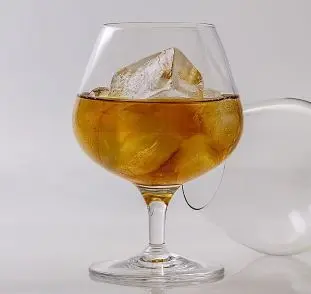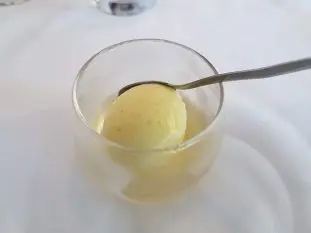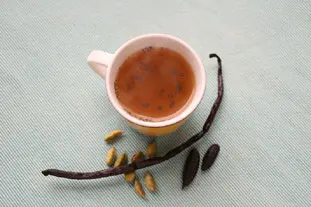This site uses only a few technical cookies necessary for its operation. By continuing to browse, you accept their use.
To find out more...
To find out more...
The return of the "Norman hole"

You maybe know the "trou normand", this old gastronomic custom typically French which consists in taking a (small) glass of calvados, generally between the last course and the dessert?
It's something that seems a bit anachronistic nowadays, having a glass of an alcohol of more than 60° in the middle of a meal, often with wines, to supposedly "ease digestion", ouch!
It's something that seems a bit anachronistic nowadays, having a glass of an alcohol of more than 60° in the middle of a meal, often with wines, to supposedly "ease digestion", ouch!
14 K 4.8/5 (13 reviews)
Keywords for this post:MealCustomNormandyNormandCalvadosSorbetLast modified on: December 18th 2021
The return of the "Norman hole"
If the original practice is rather debatable (personally, I'm almost sure that I won't see the dessert, or else in a fog :-), the principle on the other hand is not stupid: In a rather rich meal, like a holiday meal, take a little break before the dessert, and why not, by tasting something different.
It is a little bit towards that that the usage has been adapted for several decades, we always practice the Norman hole, but it is rather with something fresh, like a sorbet, often alcoholic, we do not completely remake.
The great classic, always in the Norman spirit, is a small dish with an apple sorbet, without or with a dash of calvados poured over it just before serving, or its "colonel" version with lemon and vodka sorbet.
The freshness of the sorbet, welcome at the end of the meal, is typical of what great restaurants call the pre-dessert.
In the end, it is a certain contrast that is sought, we have just eaten the main course, often quite substantial, perhaps washed down with strong wines, our mouths are a little full, a touch of lightness, of freshness, would be welcome.
Someone who is a bit strict might tell you to stop fussing, and simply drink a glass of fresh water, that it would be enough, and he would probably be right, but it is a holiday meal, we want to get out of the ordinary.
But instead of limiting yourself to the two initial options, alcohol alone (classic but outdated) or sorbet/ice (more modern but overused), it is also possible to think outside the box and go for something more daring, here are some ideas for, perhaps, your upcoming holiday meals.
- You don't serve anything with it, no little cookies or sweets, that would be too much.
- We serve the guests, and we sit with them right away, it is also a moment of exchange, the preparation of the dessert can wait a little.
- Or something fresh like a small iced coffee, a fruit mousse, a very light cream, a red fruit chantilly, or even a small fresh fruit salad.
- More daring, it could be something hot: a sabayon, vanilla or with a hint of citrus, served in a tiny cup.
- Last hot/tidy idea: mulled apple juice (my favourite), or hot cider.
In all of this, you should find something that will pass the "trou normand" test with flying colors with your guests, and who knows, maybe even surprise them a bit.
In summary:The "trou normand" in its principle, a refreshing break in a meal, is a good idea that can be declined in many ways, not necessarily alcoholic.
It is a little bit towards that that the usage has been adapted for several decades, we always practice the Norman hole, but it is rather with something fresh, like a sorbet, often alcoholic, we do not completely remake.
The great classic, always in the Norman spirit, is a small dish with an apple sorbet, without or with a dash of calvados poured over it just before serving, or its "colonel" version with lemon and vodka sorbet.
The freshness of the sorbet, welcome at the end of the meal, is typical of what great restaurants call the pre-dessert.

In the end, it is a certain contrast that is sought, we have just eaten the main course, often quite substantial, perhaps washed down with strong wines, our mouths are a little full, a touch of lightness, of freshness, would be welcome.
Someone who is a bit strict might tell you to stop fussing, and simply drink a glass of fresh water, that it would be enough, and he would probably be right, but it is a holiday meal, we want to get out of the ordinary.
But instead of limiting yourself to the two initial options, alcohol alone (classic but outdated) or sorbet/ice (more modern but overused), it is also possible to think outside the box and go for something more daring, here are some ideas for, perhaps, your upcoming holiday meals.
A few rules that can't be ignored
- We stick to something small, a ramekin for example is too big, you need a very small glass, or a cup, or an espresso/ristretto cup.- You don't serve anything with it, no little cookies or sweets, that would be too much.
- We serve the guests, and we sit with them right away, it is also a moment of exchange, the preparation of the dessert can wait a little.
And some suggestions
-It can be something very cold, a fruit sorbet with a little acidity for example: apple already mentioned, citrus fruits (clementine for example) or red fruits.- Or something fresh like a small iced coffee, a fruit mousse, a very light cream, a red fruit chantilly, or even a small fresh fruit salad.
- More daring, it could be something hot: a sabayon, vanilla or with a hint of citrus, served in a tiny cup.
- Last hot/tidy idea: mulled apple juice (my favourite), or hot cider.

In all of this, you should find something that will pass the "trou normand" test with flying colors with your guests, and who knows, maybe even surprise them a bit.
In summary:The "trou normand" in its principle, a refreshing break in a meal, is a good idea that can be declined in many ways, not necessarily alcoholic.
Lasts posts
Butter vs. grease
We often read in a recipe where a pastry is put into a mould that, just before pouring, the mould should be buttered or greased. But what's the difference between these 2 terms?December 1st 20256045
Getting out of the fridge early
Very often when you're cooking, you need to take food or preparations out of the fridge, to use them in the recipe in progress. There's nothing tricky about this: you just take them out of the fridge and use them, usually immediately, in the recipe. But is this really a good method?November 24th 20259395
Who's making the croissants?
When you look at a bakery from the outside, you naturally think that in the bakery, the bakers make the bread, and in the laboratory, the pastry chefs make the cakes. It's very often like that, with each of these professions having quite different ways of working, but sometimes there's also one...November 23th 2025841
Oven height
When we put a dish or cake in the oven, we naturally tend to put it on the middle shelf, and that's what we usually do. But in some cases, this position and height can be a little tricky, so let's find out why.October 8th 20252,4275
The importance of sieving
In recipes that use a fine powder (flour, powdered sugar, etc.), you'll often see the advice to sift before using it. To sift is to pass the powder in question through a sieve (a very fine strainer) before incorporating it into your recipe. It's often advice, but is it really useful?September 3rd 20257,3203
Other pages you may also like
Tranché, dissociated, failed, in short... missed!
When preparing a sauce or a cream, there's always a (small) risk that the creamy preparation you're working on will suddenly separate into two parts of different textures: a liquid part, for example, and a more or less solid part, or even become lumpy. It's terribly frustrating, but we'll see...June 19th 202312 K5
Candied fruits: don't get ripped off
Do you like candied fruit? You might like to nibble a handful or add it to a recipe, like a classic fruit cake or delicious Italian specialities like panettone or sicilian epiphany pie.June 21th 201767 K 24.2
Egg yolks and caster sugar
We often come across recipes where we need to mix egg yolks with caster sugar. This would appear to be a very ordinary and simple thing to do but, be warned, these two ingredients can behave oddly together.February 15th 201882 K 24.3
Butter doesn't make you fat, unless you eat too much of it.
Whenever I'm discussing cooking and recipes, there is one idea which comes up frequently, like this: "Oh no! But that's got butter in it" (I should add, for the sake of accuracy, that this is something I hear more frequently from women, who are almost all concerned with keeping their figure). ...March 26th 201245 K4.5
The 3 kinds of meringue
Meringue – what could be simpler? Just beaten egg whites with sugar added. This makes a fairly stiff mixture which can then be cooked in a cool oven to create those lovely, light confections. But in the world of professional patisserie, meringue comes in three different kinds. Even if the...June 14th 201364 K4.5
Post a comment or question
Follow this page
If you are interested in this page, you can "follow" it, by entering your email address here. You will then receive a notification immediately each time the page is modified or a new comment is added. Please note that you will need to confirm this following.
Note: We'll never share your e-mail address with anyone else.
Alternatively: you can subscribe to the mailing list of cooling-ez.com , you will receive a e-mail for each new recipe published on the site.









